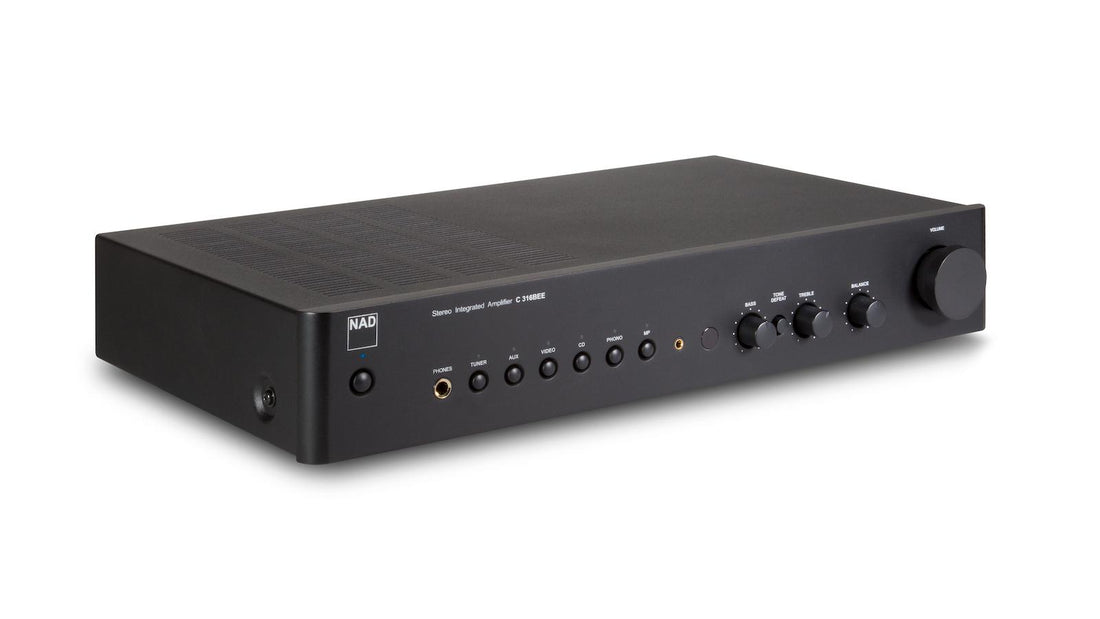
NAD C 316BEE V2 Integrated Amplifier Review
First impressions are never wrong. Always go with your gut.
Over the past 40 years, I have been fortunate to listen to a lot of audio equipment manufactured by NAD; the Lenbrook Group which also manufactures Bluesound and PSB loudspeakers is a hometown brand that I have supported as both a customer and member of the audio/video press for almost two decades. My audio journey started at Bay Bloor Radio; founded by the late-Sol Mandlsohn who influenced more Canadian audiophiles than any publication and who introduced me to high-end audio when I was only 10.
NAD was a fixture at Bay Bloor Radio, and it was one of the first products that I ever experienced, along with Yamaha, Marantz, Carver, Celestion, and Bang & Olufsen. It is very possible that the NAD C 316BEE V2 integrated amplifier is one of the finest components they offer – as important as the M10 V2 streaming amplifier or Masters M33 streaming DAC amplifier that are perched at the top of the NAD pyramid and represent the future of this hobby.

The C 316BEE V2 ($449) is just a simple integrated amplifier without a streaming module, internal DAC, or wireless capabilities. Nada. Before you get too excited about its tone controls on the front panel, headphone jack, or credit card-sized remote control, the most important feature of the C 316BEE V2 is its phono pre-amplifier which sealed the deal for me; and I suspect a lot of vinyl newbies who may want to really hear what their turntable might be capable of.
Why is that so important?
Based on my experience with some of the turntables currently offering internal phono pre-amplifiers, they are being shortchanged. In a big way.
During my recent phono pre-amplifier survey, I had the opportunity to compare the C 316BEE’s internal phono pre-amp against some very strong contenders from Schiit Audio, Cambridge Audio, U-Turn, Pro-Ject, Croft, and Moon by SimAudio. Unless you can afford one of the pricier options on the list – you will be just fine with the NAD.

The Guts
NAD’s power ratings have always been a tad wonky. The C 316BEE V2 is rated at 40 watts per channel into 8 ohms (60 watts per channel into 4 ohms) and my listening experience suggests that the amplifier is capable of far more output. The Toroidal power transformer is well isolated and there is clearly something always in reserve because the performance of the amplifier with every loudspeaker I have at home; with the exception of the Magnepan LRS, and brand new Sonus faber Lumina I was effortless for the most part.
The C 316BEE V2 drove the Q Acoustics 3030i & 3050i, PSB Alpha P5, Wharfedale Diamond 12.1, and Focal CHORA 806 without breaking a sweat.
The synergy with the Q Acoustics 3050i was the most intriguing and where most of my listening impressions will be focused.
Aside from the internal MM phono stage, the C 316BEE V2 also includes 4 additional inputs which is more than enough for most systems. A pair of binding posts on the real panel facilitates connection with either banana pins or bare wire and the unit comes equipped with a fixed power cord. The front panel also features an input for smart phones and tablets.
Unlike a lot of the new offerings from NAD, the C 316BEE V2 is a class AB amplifier and does not utilize NAD’s next generation HybridDigital Purifi Eigentact technology. The C 316BEE V2 can be left in standby mode (it draws less than 1 watt of power in this mode) and it rarely got warm to the touch even during long listening sessions.
It is never going to take up a lot of space in your equipment rack or even placed on a credenza, but the C 316BEE V2 (17”W x 4”H x 11.25”D) does benefit from keeping its top panel vents unobstructed.
Set-up
For a majority of the review process, the NAD C 316BEE V2 split its time in my dining room system and home office which are relatively large rooms (19’ x 13’ x 9’ and 33’ x 13’ x 8’); the basement home office also features an acoustically treated home theater space and Berber carpeting making it less reverberant/bright sounding. The dining room set-up allowed me to place the C 318BEE V2 on a solid wood credenza flanked by the NAD C 588 turntable, and Pro-Ject Tube Box DS2 phono pre-amplifier. All cabling was from Audio Art, Analysis Plus, and AudioQuest.
In the basement system, I streamed Tidal and Qobuz via Roon from an iMac and utilized my Thorens TD-160 Super/Ortofon 2M Black set-up to challenge the internal phono stage. Loudspeakers included the aforementioned PSB Alpha P5, Wharfedale Diamond 10.1 & 12.1, and Q Acoustics 3050i in both rooms. DACs included the AudioQuest Dragonfly Cobalt, and Schiit Audio Gungnir Multibit.
I Will Not Feel Shame About the Mall Pretzels…
And nor should anyone feel shame about making the NAD C 316BEE the heart of their stereo system.
When NAD shipped me their C 588 turntable for a different review, I grimaced somewhat when I saw that the table came equipped with the Ortofon 2M Red MM cartridge. I’ve been a proud owner of the 2M Black for almost 3 years, but the 2M Red has always left me rather cold with its tipped up tonal balance. I wasn’t overly optimistic that the NAD’s phono section would work very well with the cart, and nor would the Q Acoustics 3050i love it either.
About 3 tracks into Freddie Hubbard’s Hub-Tones (Blue Note 80 Vinyl Reissues, ST-84115), I realized that while not the last word in detail or top end extension, the trio of components were working incredibly well together.
The Q Acoustics 3050i are the antithesis of bright sounding, and the midrange could use some sparkle. Hubbard’s trumpet playing is vibrant, powerful, and the recording is anything but laid-back sounding.
The NAD amplifier most certainly has a bump in the midrange; even into the upper midrange which worked wonders with both horns and vocals on a loudspeaker with a such a restrained presentation.
I still find the 2M Red to be far too lit up in the treble, but the C 316BEE’s tonal balance took some of the edge off and let the smooth sounding tweeter on the 3050i do its thing.
Synergy is a thing. Not to be underestimated when assembling a system regardless of price.
Nobody is ever going to confuse the C 316BEE V2 with a tube amplifier, but its midrange is most certainly warm sounding – albeit with more sharply drawn lines when it comes to the body of instruments and vocalists. There is nothing diffuse about its sound or the depth of the soundstage which is above average for an amplifier at its price point.
The 3050i has relatively low-end bass response, but it is not the last word when it comes to definition. I’ve had the chance to audition it with the Edge A integrated amplifier from Cambridge Audio ($6,000) and while the much more powerful amplifier did a lot to tighten up the bass response, and thrust its presentation forward of the cabinet into my listening space – the average 3050i buyer is not using it with a $6,000 amplifier.
The C 316BEE V2 is most likely not on the radar of the same buyer, but it should be because the NAD took charge of this loudspeaker and made it sound exceptional. $1,300 for this combination is quite reasonable.
The top end of the C 316BEE V2 lacks some sweetness, but it’s never going to come across as bright sounding.
When I switched over to Tidal and streamed Daft Punk’s soundtrack to Tron: Legacy, the NAD proved that it can handle electronica and unravel the layers of instrumentation and never sound out of breath.
Vocals are sufficiently fleshed out by the C 316BEE V2; there isn’t that tactile feeling I get from my Croft Phono integrated or the Wavelength Audio Duetto 300B SET amplifier that I owned for almost 8 years, but if the recording quality is there – the NAD can do it justice.
For my own edification, I connected the Pro-Ject Tube Box DS2 to one of the unused inputs and listened to the same Blue Note releases just to see what adding a $700 phono stage to the C 316BEE V2 would yield.
Depression.
Much depression as I realized that the combination was rapidly approaching the quality of my $1,800 Croft integrated for less money. The Croft still has that “thing” that makes music come alive differently; more of the passion and inner connection, but the NAD/Pro-Ject combo was nothing to stick in the corner.
I’ll take the #3 combo…
Depending on your budget, the NAD C 316BEE V2 might be the ideal integrated amplifier to build a system around. It most certainly works better with loudspeakers that could use some added color and midrange drive like the Q Acoustics 3050i, Wharfedale EVO series, and PSB Alpha P5. Stick with neutral cables and sources that don’t fall into the overly warm category and you might find as I did, that there is nothing entry-level about this integrated amplifier. It is very much a big league player with a cap-friendly price.
I suspect that I will be enjoying it for many years to come.
Published

